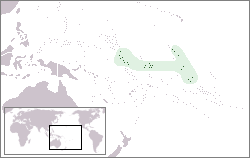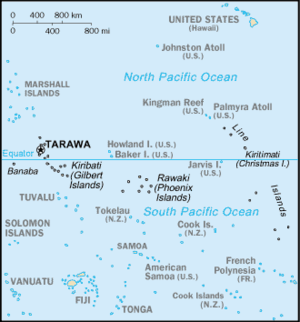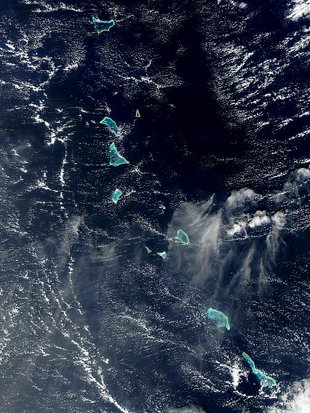Kiribati
2007 Schools Wikipedia Selection. Related subjects: Geography of Oceania (Australasia)
| Republic of Kiribati | |||||
|
|||||
| Motto: Te Mauri, Te Raoi ao Te Tabomoa (English: Health, Peace and Prosperity) |
|||||
| Anthem: Teirake Kaini Kiribati | |||||
| Capital (and largest city) |
South Tarawa |
||||
| Official languages | English | ||||
|---|---|---|---|---|---|
| Government | Republic | ||||
| - President | Anote Tong | ||||
| Independence | |||||
| - from UK | 12 July 1979 | ||||
| Area | |||||
| - Total | 726 km² ( 186th) 280 sq mi |
||||
| - Water (%) | 0 | ||||
| Population | |||||
| - July 2005 estimate | 99,350 ( 197th) | ||||
| - 2000 census | 84,494 | ||||
| - Density | 137/km² ( 73rd) 355/sq mi |
||||
| GDP ( PPP) | 2005 estimate | ||||
| - Total | $221 million1 ( 179th) | ||||
| - Per capita | $2,358 ( 136th) | ||||
| HDI (2006) | n/a (unranked) ( n/a) | ||||
| Currency | Australian dollar ( AUD) |
||||
| Time zone | ( UTC+12, +13, +14) | ||||
| Internet TLD | .ki | ||||
| Calling code | +686 | ||||
| 1 Supplemented by a nearly equal amount from external sources. | |||||
Kiribati, officially the Republic of Kiribati, is an island nation located in the central tropical Pacific Ocean. The country's 33 atolls are scattered over 1,351 square miles (3,500 km²) near the equator. Its name is pronounced ['kiribas] and is a Kiribati language rendering of "Gilberts", the English name for the main group of islands: the former Gilbert Islands. In Gilbertese there is no letter 's', the sound being represented by 'ti'. That is why the Pacific Island known as Christmas Island is known in the language of Kiribati as Kiritimati Island. This island should not be confused with the Christmas Island in the Indian Ocean, which is administered by Australia.
History
Kiribati was inhabited by a single Micronesian ethnic group that spoke the same Oceanic language for 2,000 years before coming into contact with Europeans. The islands were first sighted by British and American ships in the late 18th and early 19th centuries. The islands were named the Gilbert Islands in 1820 by a Russian admiral, Adam von Krusenstern, and French captain Louis Duperrey, after a British captain, Thomas Gilbert, who crossed the archipelago in 1788 ('Kiribati' is the islanders' pronunciation of plural 'Gilberts').
The first British settlers arrived in 1837. In 1892, the Gilbert Islands became a British protectorate together with the nearby Ellice Islands. The Gilbert and Ellice Islands became a Crown colony in 1916. Kiritimati (Christmas Island) became a part of the colony in 1919 and the Phoenix Islands were added in 1937.
Tarawa Atoll and others of the Gilbert group were occupied by Japan during World War II. Tarawa was the site of one of the bloodiest battles in U.S. Marine Corps history when Marines landed in Nov. 1943, the Battle of Tarawa was fought at Kiribati's former capital Betio on Tarawa Atoll.
The Gilbert Islands and Ellice Islands gained self-rule in 1971, and were separated in 1975 and granted internal self-government by Britain. In 1978, the Ellice Islands became the independent nation of Tuvalu, and Kiribati's independence followed on July 12, 1979. In a treaty signed shortly after independence and ratified in 1983, the United States relinquished all claims (previously asserted under the Guano Act) to the sparsely inhabited Phoenix Islands and those of the Line Islands that are part of Kiribati territory.
Overcrowding has been a problem, and in 1988 it was announced that 4,700 residents of the main island group would be resettled onto less populated islands. In 1994, Teburoro Tito was elected president. Kiribati's 1995 act of moving the international date line far to the east to encompass Kiribati's Line Islands group, so that it would no longer be divided by the date line, courted controversy. The move, which fulfilled one of President Tito's campaign promises, was intended to enable Kiribati to become the first country to see the dawn on January 1, 2000, and welcome the date popularly, but incorrectly, taken to be the start of the third millennium AD — an event of significance for tourism. Tito was reelected in 1998. In 1999, Kiribati gained UN membership.
In 2002, Kiribati passed a controversial law enabling the government to shut down newspapers. The legislation followed the launching of Kiribati's first successful nongovernment-run newspaper. President Tito was reelected in 2003, but in March 2003, he was removed from office by a no-confidence vote, and replaced by a Council of State. Anote Tong of the opposition party, Boutokaan Te Koaua, was elected to succeed Tito in July 2003.
Many of the islands of Kiribati especially in the remote Line Islands, were formerly used by the United States and Great Britain for atomic bomb testing. According to Kiribati: A People's History, Kiribati was the testing sites for many of the new H-Bombs in the 1960's.
Politics
The politics of Kiribati takes place in a framework of a presidential representative democratic republic, whereby the President of Kiribati is the head of government, and of a pluriform multi-party system. Executive power is exercised by the government. Legislative power is vested in both the government and the House of Assembly. The Judiciary is independent of the executive and the legislature.
Administrative divisions
Kiribati was formally divided into districts until its independence. The country is now divided into three island groups which have no administrative function, including a group that unites the Line and the Phoenix islands (ministry at London, Christmas). Each inhabited island has its own council (3 councils on Tarawa: Betio, South-Tarawa, North-Tarawa; 2 councils on Tabiteuea). The original districts used to be:
- Banaba
- Central Gilberts
- Line Islands
- Northern Gilberts
- Southern Gilberts
- Tarawa Atoll
The island groups include:
- Gilbert Islands
- Phoenix Islands
- Line Islands
Four of the former districts (including Tarawa) lie in the Gilbert Islands, where most of the country's population lives. Only three of the Line Islands are inhabited. The Phoenix Islands are uninhabited except for Kanton, and have no representation. Banaba itself is sparsely inhabited now. There is also a non-elected representative of the Banabans on Rabi Island in the nation of Fiji. Each of the 21 inhabited islands has a local council that takes care of the daily affairs. Tarawa Atoll has three councils: Betio Town Council, Te Inainano Urban Council (for the rest of South Tarawa) and Eutan Tarawa Council (for North Tarawa).
Geography
Kiribati consists of about 32 atolls and one island (Banaba), with at least three in each hemisphere. The groups of islands are:
- Banaba: an isolated island between Nauru and the Gilbert Islands.
- Gilbert Islands: 16 atolls located some 930 miles (1,500 km) north of Fiji
- Phoenix Islands: 8 atolls and coral islands located some 1,100 miles (1,800 km) southeast of the Gilberts
- Line Islands: 8 atolls and one reef, located about 2,050 miles (3,300 km) east of the Gilberts.
Banaba (or Ocean Island) is a raised-coral island that was once a rich source of phosphates, but it was mostly mined out before independence. The rest of the land in Kiribati consists of the sand and reef rock islets of atolls or coral islands that rise but a few meters (at most 6.5 feet) above sea level. The soil is thin and calcareous, making agriculture very difficult. Kiritimati (Christmas Island) in the Line Islands is the world's largest atoll. Based on a 1995 realignment of the International Date Line, Kiribati is now the easternmost country in the world, and was the first country to enter into the year 2000 at Caroline Island, which, not coincidentally, has been renamed Millennium Island.
According to the South Pacific Regional Environment Program, two small uninhabited Kiribati islets, Tebua Tarawa and Abanuea, disappeared underwater in 1999. The islet of Tepuka Savilivili (Tuvalu; not a Gilbertese name) no longer has any coconut trees due to salination. The United Nations Intergovernmental Panel on Climate Change predicts that sea levels will rise by about half a meter (20 in) by 2100 due to global warming and a further rise would be inevitable. It is thus likely that within a century the nation's arable land will become subject to increased soil salination and will be largely submerged.
Economy
Kiribati has few natural resources. Commercially viable phosphate deposits were exhausted at the time of independence. Copra and fish now represent the bulk of production and exports. Tourism provides more than one-fifth of GDP.
Foreign financial aid, largely from the United Kingdom and Japan, is a critical supplement, equal in recent years to 25% to 50% of GDP. Agriculture accounts for 12.4% of GDP and 71% of labour; industry 0.9% of GDP and 1.9% of labour; trade 18.5% of GDP and 4.1% of labour; commercial trade 5.7% of GDP and 1.4% of labour; and service industries 5.7% of GDP and 1.4% of labour. The main export and import countries are Australia, USA, France, Japan, Hong Kong and Germany.
Demographics
The name of the people is Gilbertese (or I-Kiribati in their language). While English is the language of the Constitution and the law, the native Micronesian language, Te taetae ni kiribati, is widely spoken.
Kiribati is one of the clearest examples of overpopulation, since there is simply not sufficient water supply, arable land, solid waste disposal capacity or sanitation facilities capability on a number of the islands.
Christianity is the major religion in the country, although mixed with many practices of the indigenous beliefs.




